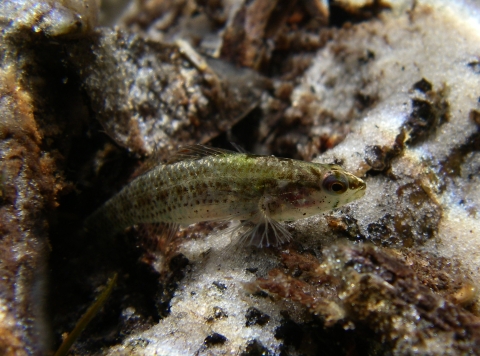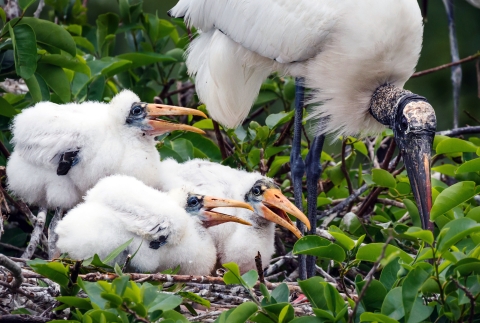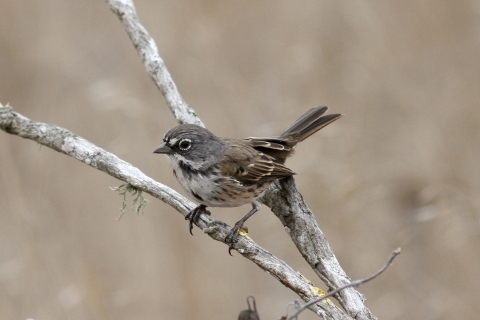The Endangered Species Act wasn’t designed to be a solo mission for us to carry out alone. Working collaboratively with others is a critical component of our mission and something relied on daily for the ESA to be successful — it is key to the progress we’re making in protecting, recovering, and delisting species under the ESA. Hundreds of species are stable, recovering, or recovered.
During this golden anniversary of the ESA, we’re celebrating the species we have recovered with our dedicated, hardworking employees and committed partners. Here are some species success stories we celebrated across the country in 2023 with some of our partners.
In the Pacific Northwest, prairies are once again colored with a bright yellow golden paintbrush — a recovery success that prompted its delisting. This vibrant perennial plant is native to the prairies of Washington, Oregon, and southern British Columbia. As those prairie ecosystems were dramatically fractured and reduced in size by development, agriculture, and fire suppression, golden paintbrush became increasingly rare. However, public and private partners, including the Washington Department of Natural Resources Natural Heritage Program, Washington State Parks, and Oregon Department of Fish and Wildlife, worked hard to help populations rebound in recent years. At the time the species was federally protected as threatened in 1997, fewer than 20,000 plants remained at just 10 sites. By 2018, hundreds of thousands of plants could be found at 48 sites. Today, the species has rebounded to over 325,000 plants at 48 locations from the Puget Trough of southwestern British Columbia and western Washington into Oregon’s Willamette Valley. Another prairie success in 2023: Nelson’s Checker-mallow.
In Florida, more than 30 years of best management practices of species recovery demonstrate the strength of partnerships that led to the recovery and ultimately the delisting of Florida’s Okaloosa darter. The U.S. Air Force’s commitment to improving the species’ aquatic habitat on Eglin Air Force Base prompted us to delist the darter in June. More than 90% of Okaloosa darters occupy six streams on land managed by Eglin Air Force Base. Since the fish was protected as endangered in 1973, habitat restoration efforts on 480 acres of land have reduced erosion into streams, removed barriers to fish passage fish passage
Fish passage is the ability of fish or other aquatic species to move freely throughout their life to find food, reproduce, and complete their natural migration cycles. Millions of barriers to fish passage across the country are fragmenting habitat and leading to species declines. The U.S. Fish and Wildlife Service's National Fish Passage Program is working to reconnect watersheds to benefit both wildlife and people.
Learn more about fish passage , and reconnected streams. A population that once numbered fewer than 10,000 fish has grown to more than 600,000 individuals.
Speaking of fish, collaborative conservation was key to saving Arizona’s state fish and prompted us to propose delisting it in August. Apache trout populations are rebounding because of conservation efforts led by the White Mountain Apache Tribe in collaboration with the U.S. Forest Service, the Arizona Game and Fish Department, and Trout Unlimited. Arizona’s state fish, the Apache trout is native exclusively to the streams in and around the White Mountains in the eastern part of the state.
In 1973, the Apache trout gained protection under the ESA and was subsequently downlisted to threatened in 1975. A major threat to the Apache trout populations has been the introduction of non-native trout. The gene pool was threatened by hybridization with non-native rainbow and cutthroat trout. Additionally, non-native brook and brown trout pose threats through competition and predation. Much of the collaborative conservation work has involved removing these introduced trout from Apache trout habitat and constructing barriers to block further non-native invasions. (Read The Perfect Cast)
On Valentine’s Day, weproposed delisting Florida’s beloved wood stork— a major conservation milestone for these hefty wading birds with football-shaped bodies perched atop long legs . The species faced extinction when protected in 1984 under the ESA. The recovery of the wood stork is a success story demonstrating that through partnerships working to restore wetland habitats, a species can be brought back from the brink of extinction.
The population decreased from 20,000 nesting pairs to less than 5,000 pairs, primarily nesting in south Florida’s Everglades and Big Cypress ecosystems. Today, the wood stork breeding population has doubled to 10,000 or more nesting pairs and increased its range, including the coastal plains of Mississippi, Alabama, Florida, Georgia, South Carolina, and North Carolina. These birds more than tripled their number of nesting colonies from 29 to 99 in their expanded range. They’ve adapted to new nesting areas, moving north into coastal salt marshes, old, flooded rice fields, floodplain forest wetlands, and human-created wetlands.
We started the anniversary year by announcing the full recovery and delisting of five species on San Clemente Island. Decades of collaborative conservation efforts on U.S. Navy-owned San Clemente Island resulted in the delisting of five species – San Clemente Island paintbrush, lotus, larkspur and bush-mallow plants, and San Clemente Bell’s sparrow. The Navy prioritized removing non-native herbivores from the island, allowing the habitat to recover. What was once a largely barren landscape now supports numerous endemic species of plants and animals, including the five species removed from the federal lists of threatened and endangered species.
San Clemente Island is one of eight islands that make up the Channel Islands off the coast of Southern California. The successful recovery of four plants and one bird adds to the list of species that have now successfully recovered across the islands, including the island night lizard, island fox, and the Santa Cruz Island dudleya and island bedstraw. Bald eagle and peregrine falcon populations decimated by impacts from harmful insecticides have also rebounded nationally and are successfully breeding on the Channel Islands.
While we and partners across the country have much to celebrate this year, many more accomplishments have been celebrated in the last 50 years. The ESA has been highly effective and credited with saving 99% of listed species from extinction. Through the ESA, we have recovered our national symbol, the bald eagle. We have also recovered the American alligator, which after surviving for millions of years, became endangered due to market hunting and loss of habitat and required protection under the ESA.
The ESA gave these species and many other species a chance to survive. Because of partners, these species have a future.







